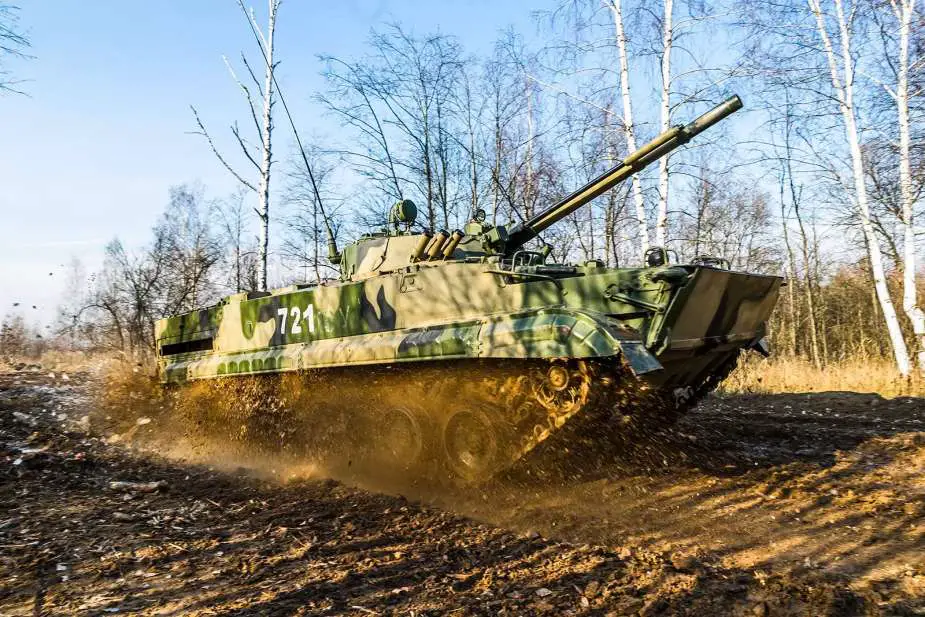On April 5, 2024, the Russian Rostec state corporation, through its subsidiary Kurganmashzavod, announced the delivery of a new batch of BMP-3 infantry fighting vehicles (IFVs) to the Russian Ministry of Defense. In addition to supplying BMP-3 vehicles, Rostec announced its plans to supply the new 2S38 Derivatsiya-PVO, based on the same chassis, to counter drones in Ukraine.
Follow Army Recognition on Google News at this link

The newly formed Russian 49th separate air assault brigade will soon benefit from the BMP-3's capabilities. (Picture source: Russian social media)
Over the past two years, Kurganmashzavod has seen an increase in the production of military equipment. This increase is in response to the objectives set by the Ministry of Defense of the Russian Federation, necessitating an expansion in production capabilities and workforce. To support this growth, the company initiated a special operating regime in 2022, which included hiring over 2,000 workers ranging from specialists to those in basic professions. Despite these efforts, there remains an ongoing need for highly skilled personnel, particularly in roles such as machine tool operation and equipment maintenance.
In 2023, Kurganmashzavod completed its delivery of BMP-3 and BTR-MDM amphibious armored personnel carriers to the Ministry of Defense, fulfilling the contractual agreements for that year. Following this delivery, the company has continued to produce infantry fighting vehicles to meet additional orders. This involves modernizing production facilities and expanding the workforce to maintain production levels.
Despite Russia experiencing significant losses of armored vehicles in Ukraine, including a reported total of 329 BMP-3 vehicles, the country's defense industry has initiated updates to the BMP-3 platform. These updates are geared towards automation and the introduction of unmanned operational capabilities, highlighted by the development of the BMP-3 Sinitsa. In addition to these advancements, there has been an increase in the delivery of various types of armored vehicles to strengthen Russian military forces to compensate the increased losses of BMP-3 IFVs. Furthermore, Russian servicemen have adapted their BMP-3 tactics in the Kupyansk area, notably shifting to the use of indirect fire to address vulnerabilities identified by Ukrainian forces.
The strategic importance of the BMP-3 infantry fighting vehicles is further highlighted by their future allocation to the newly formed 49th separate air assault brigade of the 58th Combined Arms Army of the Russian Armed Forces. The brigade, tasked with storming Ukrainian fortifications and conducting helicopter landings in hostile territory, will significantly benefit from the BMP-3's capabilities.
As a direct successor to the BMP-1 and BMP-2 infantry fighting vehicles (IFVs), the BMP-3 entered service with the Soviet army in 1990, with its production handled by Kurganmashzavod for the chassis and the Instrument Design Bureau (KBP) of Tula for the turret system. Designed to engage both ground and aerial targets while stationary, on the move, or afloat, marking a notable evolution in the BMP vehicle series. The BMP-3 saw its first significant export deal with Abu Dhabi, part of the United Arab Emirates, which ordered 330 units, receiving deliveries between 1992 and 1995. These units were customized with specific modifications including a thermal sight for enhanced targeting capabilities. In 2015, Iraq also placed an order for 300 BMP-3 vehicles, as reported by the Stockholm International Peace Research Institute (SIPRI).
The armament of the BMP-3 includes a primary 100mm 2A70 semi-automatic rifled gun/missile launcher capable of firing both conventional rounds and guided missiles, supplemented by a 30mm 2A72 coaxial cannon and a 7.62mm PKT coaxial machine gun. This setup enables the BMP-3 to engage a variety of targets, including tanks equipped with explosive reactive armor and slow-moving aerial targets like helicopters. The vehicle's armament is supported by an automatic fire control system that allows for the engagement of targets at distances of up to 4,000 m, with the system offering both manual and automatic modes of operation.
For protection and mobility, the BMP-3 features a hull and turret made from welded aluminum, offering resistance against small arms fire and shell fragments. The design includes spaced armor as a standard feature, with the option for additional explosive reactive armor for increased protection. Powered by a V-shaped UTD-29 diesel engine, the BMP-3 can reach speeds of up to 70 km/h on land and 10 km/h in water, facilitated by its hydropneumatic suspension system that allows for adjustment of the vehicle's ground clearance. The BMP-3 is also equipped with amphibious capabilities, enabling operation in various environments, supported by standard and optional equipment including NBC protection systems and thermal night vision.
The BMP-3 has been developed into several variants to serve different roles within and outside the Russian Army. These variants include the BMP-3M with updated armament and protection features, the BMMP for naval infantry, the BMP-3K command vehicle, and the BMP-3F designed for amphibious operations. Other specialized variants are focused on roles such as reconnaissance, armored recovery, anti-tank missions, and fire support, illustrating the platform's flexibility and adaptability to meet diverse operational requirements. Shortly, the BMP-3 will also serve as the basis of the 2S38 Derivatsya-PVO 57 mm anti-aircraft artillery system, developed to replace both the ZSU-23-4 Shilka and 2S6 Tunguska within the Russian Armed Forces.
















